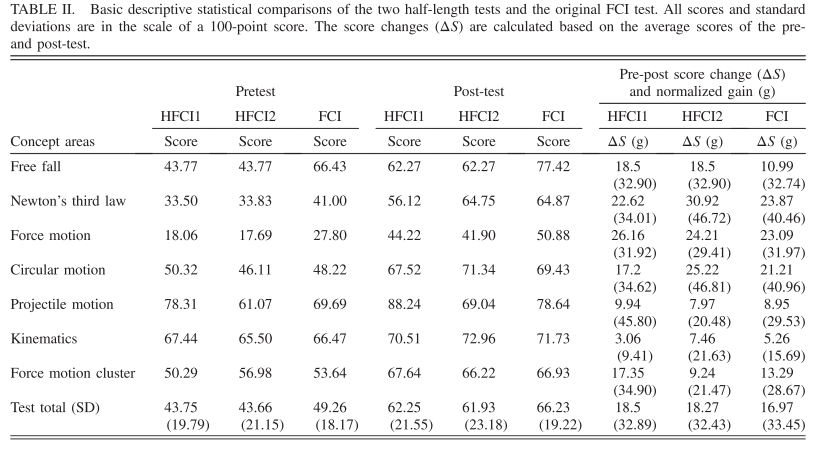Developed by Jing Han, Lei Bao, Li Chen, Tianfang Cai, Yuan Pi, Shaona Zhou, Yan Tu, and Kathleen Koenig
| Purpose | Assess the topics on the FCI in less time, with two equivalent parallel half-length versions (HFCI1 and HFCI2). |
|---|---|
| Format | Pre/post, Multiple-choice |
| Duration | 15 min |
| Focus | Mechanics Content knowledge (forces, kinematics) |
| Level | Intro college, High school |
Sample question from the HFCI:

HFCI Implementation and Troubleshooting Guide
Everything you need to know about implementing the HFCI in your class.
Login or register to download the implementation guide.
more details
This is the second highest level of research validation, corresponding to at least 5 of the validation categories below.
Research Validation Summary
Based on Research Into:
- Student thinking
Studied Using:
- Student interviews
- Expert review
- Appropriate statistical analysis
Research Conducted:
- At multiple institutions
- By multiple research groups
- Peer-reviewed publication
The multiple-choice questions on the HFCI1 and HFCI2 were taken from the original FCI (v95). To create these two half-length tests, physics education researchers first hand picked questions for each shorter test. They tested the shorter tests (HFCI1 and HFCI2) using a large scale FCI data set and a computational regression process to sort through the possible combinations of the two short tests to identify the optimal construction that minimizes the total errors among the mean scores of the different tests. They also used Item Response Theory (IRT) to to estimate and compare the assessment features (difficulty, discrimination, and students' guessing parameters) of the two short tests and the FCI test. They developers found that the descriptive statistics, the total scores, score changes, and normalized gains of the two short tests provide equivalent measures of student performances and learning gains. They also found that the tests had similar assessment features. The FCI scores are slightly but consistently higher than those of the short tests. To allow direct comparisons between the half-length and full-length FCI scores, linear models have been created that relate the scores from these tests. The developers analyzed data from over 4000 university and high school students at three institutions. Results are published in two peer-reviewed publications.
References
- J. Han, L. Bao, L. Chen, T. Cai, Y. Pi, S. Zhou, Y. Tu, and K. Koenig, Dividing the Force Concept Inventory into two equivalent half-length tests, Phys. Rev. ST Phys. Educ. Res. 11 (1), 010112 (2015).
- J. Han, K. Koenig, L. Cui, J. Fritchman, D. Li, W. Sun, Z. Fu, and L. Bao, Experimental validation of the half-length Force Concept Inventory, Phys. Rev. Phys. Educ. Res. 12 (2), 020122 (2016).
We don't have any translations of this assessment yet.
If you know of a translation that we don't have yet, or if you would like to translate this assessment, please contact us!
| Typical Results |
|---|
Data from Han et. al 2015 containing unmatched pre- and post-test scores for 3139 students on the pretest and 2526 students on the post-test. The results show that the total scores of the two half- length tests are virtually identical; the difference is 0.09% on pretest and 0.32% on post-test. Because of the removal of several high-scoring FCI questions, the scores of the half-length tests are typically 5% lower than that of the FCI.
|
The latest version of the HFCI, released in 2015, is version 1.
Variation
|
|
Force Concept InventoryContent knowledge Mechanics (forces, kinematics)Intro college, High school Pre/post, Multiple-choice |




